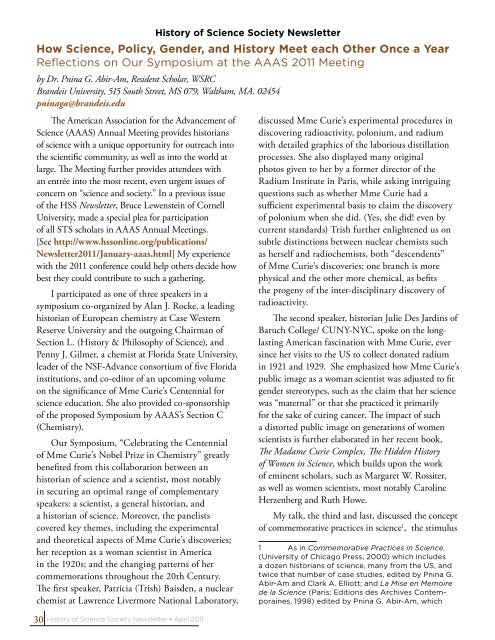Printer friendly version of Newsletter - History of Science Society
Printer friendly version of Newsletter - History of Science Society
Printer friendly version of Newsletter - History of Science Society
Create successful ePaper yourself
Turn your PDF publications into a flip-book with our unique Google optimized e-Paper software.
The American Association for the Advancement <strong>of</strong><br />
<strong>Science</strong> (AAAS) Annual Meeting provides historians<br />
<strong>of</strong> science with a unique opportunity for outreach into<br />
the scientific community, as well as into the world at<br />
large. The Meeting further provides attendees with<br />
an entrée into the most recent, even urgent issues <strong>of</strong><br />
concern on “science and society.” In a previous issue<br />
<strong>of</strong> the HSS <strong>Newsletter</strong>, Bruce Lewenstein <strong>of</strong> Cornell<br />
University, made a special plea for participation<br />
<strong>of</strong> all STS scholars in AAAS Annual Meetings.<br />
[See http://www.hssonline.org/publications/<br />
<strong>Newsletter</strong>2011/January-aaas.html] My experience<br />
with the 2011 conference could help others decide how<br />
best they could contribute to such a gathering.<br />
I participated as one <strong>of</strong> three speakers in a<br />
symposium co-organized by Alan J. Rocke, a leading<br />
historian <strong>of</strong> European chemistry at Case Western<br />
Reserve University and the outgoing Chairman <strong>of</strong><br />
Section L. (<strong>History</strong> & Philosophy <strong>of</strong> <strong>Science</strong>), and<br />
Penny J. Gilmer, a chemist at Florida State University,<br />
leader <strong>of</strong> the NSF-Advance consortium <strong>of</strong> five Florida<br />
institutions, and co-editor <strong>of</strong> an upcoming volume<br />
on the significance <strong>of</strong> Mme Curie’s Centennial for<br />
science education. She also provided co-sponsorship<br />
<strong>of</strong> the proposed Symposium by AAAS’s Section C<br />
(Chemistry).<br />
Our Symposium, “Celebrating the Centennial<br />
<strong>of</strong> Mme Curie’s Nobel Prize in Chemistry” greatly<br />
benefited from this collaboration between an<br />
historian <strong>of</strong> science and a scientist, most notably<br />
in securing an optimal range <strong>of</strong> complementary<br />
speakers: a scientist, a general historian, and<br />
a historian <strong>of</strong> science. Moreover, the panelists<br />
covered key themes, including the experimental<br />
and theoretical aspects <strong>of</strong> Mme Curie’s discoveries;<br />
her reception as a woman scientist in America<br />
in the 1920s; and the changing patterns <strong>of</strong> her<br />
commemorations throughout the 20th Century.<br />
The first speaker, Patricia (Trish) Baisden, a nuclear<br />
chemist at Lawrence Livermore National Laboratory,<br />
30 <strong>History</strong> <strong>of</strong> <strong>Science</strong> <strong>Society</strong> <strong>Newsletter</strong> • April 2011<br />
<strong>History</strong> <strong>of</strong> <strong>Science</strong> <strong>Society</strong> <strong>Newsletter</strong><br />
How <strong>Science</strong>, Policy, Gender, and <strong>History</strong> Meet each Other Once a Year<br />
Reflections on Our Symposium at the AAAS 2011 Meeting<br />
by Dr. Pnina G. Abir-Am, Resident Scholar, WSRC<br />
Brandeis University, 515 South Street, MS 079, Waltham, MA. 02454<br />
pninaga@brandeis.edu<br />
discussed Mme Curie’s experimental procedures in<br />
discovering radioactivity, polonium, and radium<br />
with detailed graphics <strong>of</strong> the laborious distillation<br />
processes. She also displayed many original<br />
photos given to her by a former director <strong>of</strong> the<br />
Radium Institute in Paris, while asking intriguing<br />
questions such as whether Mme Curie had a<br />
sufficient experimental basis to claim the discovery<br />
<strong>of</strong> polonium when she did. (Yes, she did! even by<br />
current standards) Trish further enlightened us on<br />
subtle distinctions between nuclear chemists such<br />
as herself and radiochemists, both “descendents”<br />
<strong>of</strong> Mme Curie’s discoveries: one branch is more<br />
physical and the other more chemical, as befits<br />
the progeny <strong>of</strong> the inter-disciplinary discovery <strong>of</strong><br />
radioactivity.<br />
The second speaker, historian Julie Des Jardins <strong>of</strong><br />
Baruch College/ CUNY-NYC, spoke on the longlasting<br />
American fascination with Mme Curie, ever<br />
since her visits to the US to collect donated radium<br />
in 1921 and 1929. She emphasized how Mme Curie’s<br />
public image as a woman scientist was adjusted to fit<br />
gender stereotypes, such as the claim that her science<br />
was “maternal” or that she practiced it primarily<br />
for the sake <strong>of</strong> curing cancer. The impact <strong>of</strong> such<br />
a distorted public image on generations <strong>of</strong> women<br />
scientists is further elaborated in her recent book,<br />
The Madame Curie Complex, The Hidden <strong>History</strong><br />
<strong>of</strong> Women in <strong>Science</strong>, which builds upon the work<br />
<strong>of</strong> eminent scholars, such as Margaret W. Rossiter,<br />
as well as women scientists, most notably Caroline<br />
Herzenberg and Ruth Howe.<br />
My talk, the third and last, discussed the concept<br />
<strong>of</strong> commemorative practices in science 1 , the stimulus<br />
1 As in Commemorative Practices in <strong>Science</strong>,<br />
(University <strong>of</strong> Chicago Press, 2000) which includes<br />
a dozen historians <strong>of</strong> science, many from the US, and<br />
twice that number <strong>of</strong> case studies, edited by Pnina G.<br />
Abir-Am and Clark A. Elliott; and La Mise en Memoire<br />
de la <strong>Science</strong> (Paris: Editions des Archives Contemporaines,<br />
1998) edited by Pnina G. Abir-Am, which
















